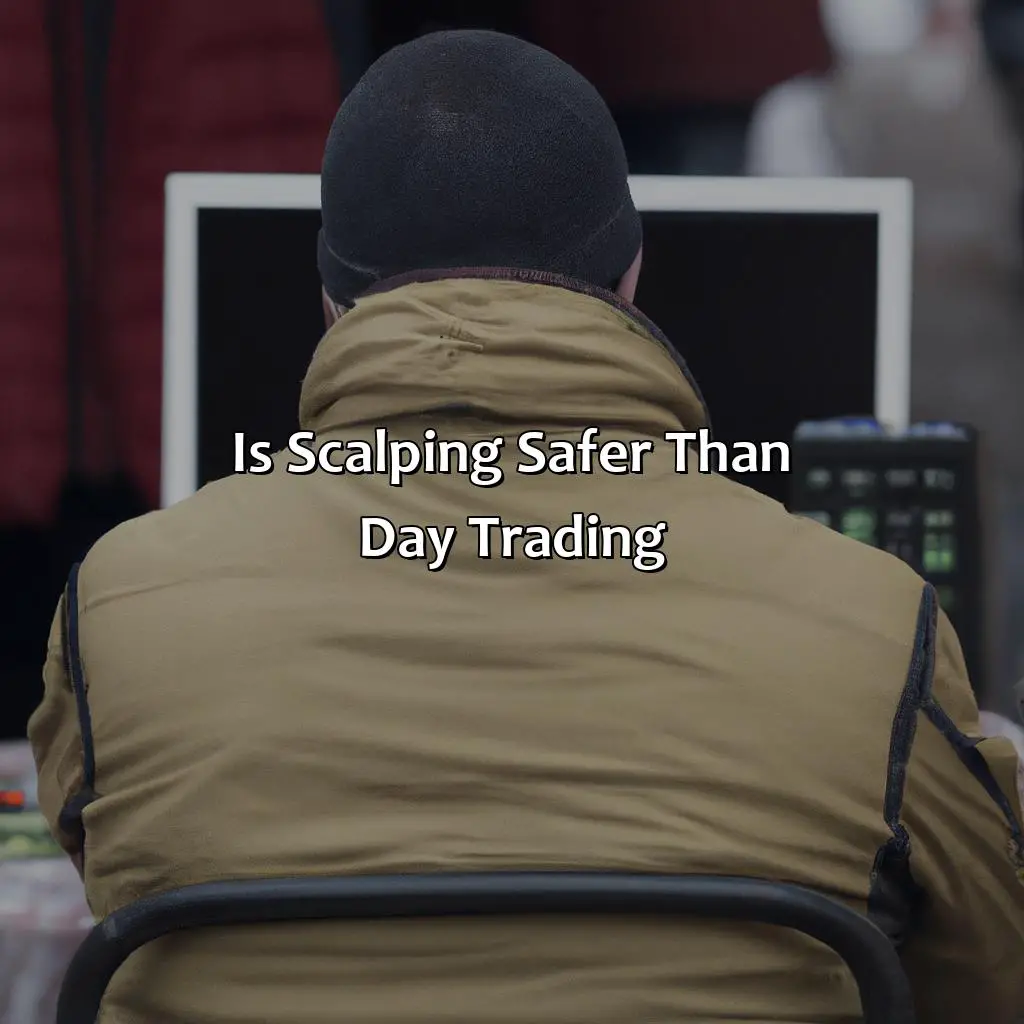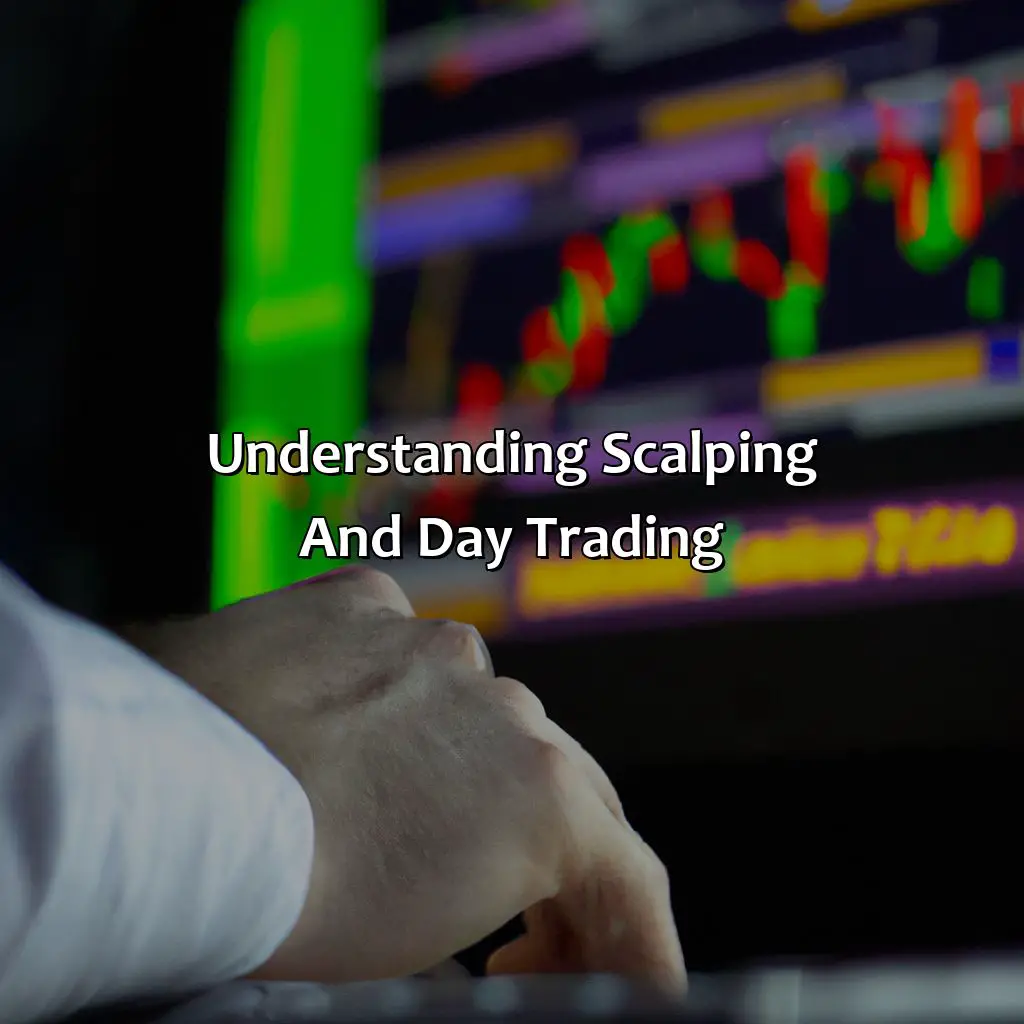
Key Takeaway:
- Scalping and day trading are both short-term trading strategies that involve buying and selling financial assets within a single trading day. Scalping is a high-frequency trading strategy that aims to make small profits from multiple trades, while day trading involves taking larger positions and holding them for a few hours or even the entire trading day.
- There are certain risks involved in scalping and day trading, such as market volatility, trading psychology, and the risk reward ratio. Traders must have a clear understanding of risk management techniques, technical and fundamental analysis, and various chart patterns and candlestick patterns to minimize these risks.
- When it comes to choosing between scalping and day trading, there is no clear answer as to which is safer. The safety of these strategies largely depends on the individual trader’s experience, skills, and trading style. Factors such as trading psychology, education, and mentoring should be considered when making a decision.
Understanding Scalping and Day Trading

Photo Credits: forexbrokerreport.com by Aaron Mitchell
Know the key differences between scalping and day trading in forex and futures. Scalping is a very short-term strategy that uses technical analysis, chart, and candlestick patterns. Day trading is more of a short-term technique that takes into account both fundamental and technical analysis. The following sub-sections will provide a better understanding of these two trading methods and the risks associated with them:
- ‘Key Differences between Scalping and Day Trading‘
- ‘The Risks Involved in Scalping and Day Trading‘
Key Differences between Scalping and Day Trading
In the world of trading, there are two primary classifications: scalping and day trading. Scalping is a short-term strategy that involves making multiple trades in a single trading session to profit from small price movements. On the other hand, day trading is a more extended term strategy whereby traders hold positions open for an entire trading session—typically buying and selling assets based on market fluctuations throughout the day.
To differentiate between scalping and day trading further, consider the following table:
| Scalp Trading | Day Trading |
|---|---|
| Short time frames used | Longer timeframes used |
| Frequent trades made | Fewer trades made |
| Minimal profits per trade | Higher profits per trade |
| Risk management vital | Risk management still important |
It’s worth noting that both scalping and day trading come with risks, such as volatile markets or non-optimal spreads. However, traders can minimize these risks by understanding the benefits and drawbacks of each approach.
Lastly, it’s fascinating to note that over time, debates have arisen about which of these methods is superior. It’s not uncommon to hear traders arguing about whether scalping or day trading leads to better returns overall. The truth is that neither method has been conclusively shown to be better than the other—it mainly depends on individual skills, experience level, objectives, risk tolerance levels and personality types.
Navigate the risks of scalping and day trading with a deep understanding of risk management, market volatility, and trading psychology.
The Risks Involved in Scalping and Day Trading
Scalping and day trading can involve risks, which need to be recognized for efficient risk management. These risks, particularly related to market volatility and trading psychology, could lead to significant losses if not handled appropriately.
Frequently performed Scalping and day trading have specific challenges that need to be acknowledged as a Risk Reward ratio needing constant check in with moving averages/trend lines while considering market sentiment.
To avoid losses associated with scalping or day trading, traders must understand their trading styles intricately. Various risks are involved when it comes down to real-time trading. One such example could be the loss of control over assets gained through scalping on high leverage with considerable uncertainty in the future markets.
In one instance, a trader blindly followed his notion based on historical data for an unpredictable current scenario leading to massive losses within minutes of executing trades. Therefore, to minimize loss possibilities while engaging in this practice, traders must invest enough time into learning trend analyses and eventually mastering various Technical Analysis techniques.
Scalping may offer quick profits, but its reliance on scalping indicators and techniques can also lead to quick losses.
The Advantages and Disadvantages of Scalping

Photo Credits: forexbrokerreport.com by Nicholas Gonzalez
Do scalping and day trading differ in safety? To answer that, let’s look at the pros/cons of scalping. Momentum trading, breakouts, indicators, and scalping techniques all affect your strategy. We’ll explore:
- Scalping systems
- Signals
- Platforms
- Software
- Online trading
- Electronic trading
- Algorithmic trading
- Automated trading
- Market making
- Order flow
- Order book
- Spread
- Liquidity
- Slippage
- Market manipulation
- Insider trading
- Commissions
- Fees
- Taxes
- Regulations
- and laws.
All have advantages and disadvantages.
Advantages of Scalping
Scalping is a trading strategy that involves making quick trades in the market to capture small price movements. This approach is often favored by traders who want to make frequent and consistent profits from the market. The benefits of scalping include:
- Focused Trading Signals for Scalping
- Quick Profit Opportunities
- Minimized Exposure to Market Volatility
- Favorable Support and Resistance Levels
- Convenient Use of Trading Software and Platforms
- Reduced Risk of Large Losses
Trading signals for scalping are ideal because they focus solely on the short-term, providing clear entry and exit points for traders. Scalping also allows for quick profit opportunities as prices can move rapidly in short periods, which leads to consistent returns. Additionally, scalpers are less exposed to market volatility as they only hold positions for a brief period.
Favorable support and resistance levels can also lead to profitable scalp trades since these key levels can act as turning points in price movements. Scalpers find it convenient to use trading software or platforms with intuitive features that allow them to quickly make trades while avoiding common errors. Furthermore, this approach reduces the risk of large losses occurring from unfavorable market conditions.
To maximize success while scalping, traders should consider factors such as online trading, algorithmic trading, low latency trading, and high frequency trading. These suggestions work due to their ability to help traders make faster decisions based on real-time information. Ultimately, carefully considering these advantages can help traders determine if scalping is a suitable trading strategy for them.
Scalping may offer quick profits, but the potential disadvantages of market manipulation and trading fees make it a risky strategy.
Disadvantages of Scalping
Scalping, a high-frequency trading strategy, has several downsides that traders should consider before implementing it. Its cons can lead to significant financial losses and other legal issues. In contrast to longer-term strategies such as day trading, scalping involves opening and closing positions in a matter of seconds or minutes, typically aiming for profits from short-term price movements.
- Slippage: This most common disadvantage is when the bid-ask spread increases dramatically as market makers adjust their pricing, leading to substantial financial loss.
- Liquidity Risk: Scalpers face higher liquidity risk than traders using longer-term holding periods due to the smaller profit per trade and further reliance on high-frequency trading opportunities.
- Trade Commissions and Fees: Higher transaction costs are associated with this type of frequent aggressive trading strategy compared to buy-and-hold styles.
Scalping’s fast-paced nature contributes to several additional downsides that require special consideration. While this method can produce quick gains, it also exposes investors to several risks that may cause them a considerable amount of money. Before engaging in scalping, traders need to take precautions and learn about potential ethical concerns such as insider trading or market manipulation.
Traders hoping to minimize drawbacks associated with scalping could keep in mind several suggestions. 1. they could conduct extensive order book research by monitoring order flow and considering bid-ask spreads before entering trades. 2. Start slow with careful trial-and-error process by staying disciplined while keeping emotions like greed out of decision-making processes. Lastly, avoiding overtrading by knowing when it’s time rest -maintain physical fitness level-good sleep hygiene good nutrition habits- giving the body sufficient time for recuperation could maintain the sharp edge required for successful scalpining and day-trading without burning out.
Day trading is a high-risk game of strategy, where technical and fundamental analysis are like bullets in a gun, and trading signals are the trigger.
The Advantages and Disadvantages of Day Trading

Photo Credits: forexbrokerreport.com by Gary Roberts
Analyzing trading strategies? Want to know if day trading is a profitable venture? Weigh the pros and cons!
The Advantages of Day Trading include trading software, platforms, and online trading. The Disadvantages of Day Trading involve market manipulation, trading fees, and trading regulations. In the end, you can decide if day trading is suitable for your financial goals.
Advantages of Day Trading
Day Trading: Benefits of Operating within a Single Day
Day trading offers multiple benefits to traders who prefer to complete their transactions within the same day. These benefits include:
- Fast Profits: Day trading provides traders with the potential for fast and substantial profits, since they open and close positions quickly.
- Flexibility: Traders can decide the frequency and timing of their trades based on the market trends without worrying about overnight risk.
- Availability of Data: Trading platforms provide different tools to help traders make decisions such as support & resistance levels, real-time charts, technical indicators, trading software, electronic trading, low latency trading, high-frequency trading making it easier to catch market trends.
Consistent execution of a day-trading strategy demands discipline, experience in interpreting market signals, and the ability to manage losses well.
Remember that just because day trading seems attractive does not guarantee profits; it is essential to do proper research before engaging in any online trading. Don’t miss out on profiting from technology advancements in electronic trading – try it today with a reliable broker.
Day trading can be risky business with factors such as market manipulation, slippage, and trading fees making for a rough ride.
Disadvantages of Day Trading
Day Trading’s Drawbacks
Day trading is a form of trading that involves buying and selling securities within the same day. It offers several benefits but also has its fair share of drawbacks that traders should consider.
- Market making and order flow can affect day traders’ profits
- The bid-ask spread can make it difficult to profit from intraday trades
- Liquidity issues may arise if there aren’t enough buyers or sellers in the market
- Slippage is also a common issue in day trading, as prices can change rapidly without warning
- Insider trading or market manipulation may be more prevalent in day trading due to short holding periods
- Trading commissions, fees, and taxes can eat into profits for frequent traders
It is important to keep these drawbacks in mind when considering day trading as an investment strategy. However, since every trader’s situation is unique, it might work well for some while not for others. Traders should always consult with their financial advisor before making investment decisions.
According to a report by Investopedia, only 1% of day traders consistently make profits from their investments. When it comes to scalpels versus day traders, the safest bet is proper risk management and stop loss/take profit strategies.
Which is Safer: Scalping or Day Trading?

Photo Credits: forexbrokerreport.com by Bradley Lee
Safety of scalping versus day trading? Analyze risk management, stop loss, and take profit factors. Consider trading psychology, education, mentoring, and resources. Compare scalping to day trading. Examine trading success, failure, mistakes, lessons, and tips.
Factors to Consider When Choosing Between Scalping and Day Trading
When deciding which trading method to pursue, various aspects must be considered. Making an informed decision plays a significant role in the profitability of the venture. One must evaluate not only their financial goals but also their personal trading psychology, trading education, trading mentoring, and availability of trading resources.
- Financial Goals: Scalping is most suitable for traders aiming for smaller profits per trade while making numerous trades daily. Day trading might be more suited to traders expecting larger returns from fewer trades.
- Time Commitment: Scalping involves executing frequent trades over short periods, making it suitable for full-time traders or those with many spare hours in a day. Day Trading requires constant attention but allows its practitioners more flexibility of time than Scalping, given that the window of opportunity is large enough to accommodate other activities that don’t demand sustained focus.
- Liquid Asset Availability: Scalp trading capital is usually much higher than that required for day trades due to volatility and market factors unique to each asset class.
- Risk Profile: Since scalping relies on taking several small gains – often as small as 5-15 pips – overall successful scalp traders opt for highly risk-adjusted strategies aimed at minimizing losses. In contrast, day trading typically entails taking bigger risks since each trade involves more substantial profit margins.
- Trading Opportunities: Successful scalpers frequently identify precise levels in which there are instant price-action events – such as sudden spikes plummeting or rising profit margins – taking advantage of them within seconds or minutes after estimating potential movements logically. Day Traders aim for less-frequently occurring upswings from predetermined set points over longer periods.
Personal factors such as discipline, patience, and emotional responses should equally be taken into account when making the choice between scalping and day trading.
In one instance in February 2013 during a live interview session hosted by Global Futures Exchange and Trading Company featuring Linda Raschke, a former professional trader with access to considerable risk capital, scalping was used unsuccessfully. The session featured trade analyses on various assets while answering questions in real-time providing interested investors trading insights. However, the decision to scalp was not always correct, and it resulted in the recording of some disappointing losses.
Trading success is achieved by learning from trading mistakes, taking trading lessons, and implementing trading tips, regardless of whether you’re scalping or day trading.
The Safety of Scalping Compared to Day Trading
Compared to Day Trading, is Scalping a safer option for achieving trading success? Scalping undoubtedly involves some risks due to the intense and rapid pace of movements involved in the process. However, learning to manage these risks can make it a relatively safe trading strategy.
- Effective Risk Management: Risk management is crucial when scalping or day trading. Get out when things are going wrong by setting tight stops and avoiding larger losses. Due to the shorter holding periods, it’s easier to cut losses in scalping.
- The Importance of Choosing a Reputable Broker: When choosing between scalping and day trading, ensure you pick a broker who allows short-term positions with low spreads. In scalping, you need instant execution and the best prices available.
- Learning from Trading Mistakes: As with any trading style, both scalping and day trading come with their unique set of mistakes. But learning from them can help build knowledge that stands you in good stead for future trades.
It’s important to note that safety concerns may vary based on your skill level as a trader and the market conditions at play. While novice traders may benefit most from wealth-building strategies associated with longer-term positions like Day Trading, expert traders can achieve short-term profits through rigorous research, analysis skills, and sound judgement.
Trading success comes from hard work gained through education, daily practice and experience – not just following popular trends or patterns blindly. It is hence vital that one understands all aspects of both styles before delving into either one headfirst.
A real-life example has shown that risk management has helped an experienced scalp trader stay profitable for over two years. By following strict guidelines regarding position sizing, stop-losses and risk/reward ratios, he adapted his plan accordingly while simultaneously using momentum gap-trading models to keep abreast of what was happening in the markets.
Don’t just learn the trading strategies, master them with these tips on risk management and performance tracking.
Tips on How to Minimize Risks in Scalping and Day Trading

Photo Credits: forexbrokerreport.com by John Thompson
Scalping and day trading are popular trading strategies for both beginners and experts. To minimize the risks associated with these strategies, traders should use the following tips:
- Do not trade on emotions
- Set stop loss and take profit levels
- Use the right indicators
- Stay updated about market news and events
- Practice with trading simulators before live trading
Traders should also keep a trading diary or log to monitor their trading performance and make necessary improvements. Backtesting and forward testing using trading simulators can also help traders in identifying their strengths and weaknesses. Additionally, traders can improve their knowledge and skills by reading trading glossary, books, taking courses, attending webinars, and watching videos and podcasts.
Pro Tip: Always use proper risk management techniques and never risk more than 1% of your account balance per trade. Remember, patience and discipline are key to success in scalping and day trading.
Five Facts About Is Scalping Safer Than Day Trading:
- ✅ Scalping involves making many small trades within a short timeframe, while day trading involves holding positions for a whole trading day. (Source: Investopedia)
- ✅ Scalping requires intense focus, discipline, and risk management strategies. (Source: Warrior Trading)
- ✅ Day trading can offer more opportunities for profit, but also carries higher risks due to more extended periods of exposure to the market. (Source: The Balance)
- ✅ Scalping can be more challenging for new traders due to the need for a high level of skill and experience to execute trades successfully. (Source: DailyFX)
- ✅ Ultimately, the safety of scalping versus day trading depends on the individual trader’s experience, risk tolerance, and strategy. (Source: FXCM)
FAQs about Is Scalping Safer Than Day Trading?
Is scalping safer than day trading?
Scalping and day trading both involve trading financial assets in the marketplace, but there are differences in their approach and execution. Scalping generally involves rapid entering and exiting of trades in response to minute price variations, while day trading deals with intraday movements. Let’s explore further to answer the question.
What are some advantages of scalping compared to day trading for inexperienced traders?
Scalping may provide a safer environment for inexperienced traders due to the smaller rewards and lower win percentages associated with this type of trading. Scalping requires quick and decisive action and demands intense evaluation of market dynamics. Compared to day trading, scalping offers smaller gains and coverage for losses, which may help reduce risk for inexperienced traders.
What similarities do scalping and swing trading share in terms of market analysis?
Both scalping and swing trading require appropriate preparation and fundamental analysis to identify the best opportunities for buying and selling financial assets. Scalpers tend to focus on higher leverage levels and lightning-fast speeds, while swing traders take a more measured approach to enter the market. Both styles share the common goal of making successful returns.
What are some of the risks of scalping compared to day trading?
Scalping involves calculated risk, and traders must be skilled in decisive decision-making to capitalize on quick market movements. The intense nature of scalping may lead to increased emotional trading, which can result in losses. Additionally, scalping can expose traders to greater risk because of the increased frequency of trades.
Can scalping and day trading be profitable small-scale operations?
Both scalping and day trading offer attractive returns, even for small-scale operations. Scalping offers smaller rewards but may provide more consistent gains over time, while day trading may offer higher potential profits but carries a greater risk of losses. Traders who carefully evaluate their options and take a disciplined approach can succeed in either trading style.
What is the final advice for traders who are looking to purchase and resell financial assets?
Before committing to either scalping or day trading, it’s important to understand the difference between the styles and the risks and rewards that go along with each. Traders should take the time to develop appropriate strategies and hone their skills through practice and study. They should also understand that success in either style of trading requires a deep understanding of market dynamics and a disciplined approach to trading.


